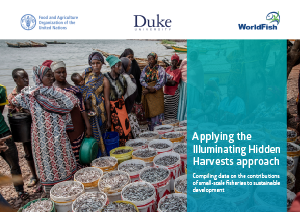This document has been adapted from the research protocol used to compile country case study data and to produce the results summarized in the 2023 report Illuminating Hidden Harvests: The Contributions of Small-Scale Fisheries to Sustainable Development (IHH), coproduced by FAO, Duke University, and WorldFish.
As the name implies, the approach was designed to compile, not collect, existing data on small-scale fisheries. Rather, this approach only reinforces the importance of collecting more detailed data specific to small-scale fisheries (for example, as distinct from large-scale fisheries, aquaculture, and recreational fisheries), to help fill the knowledge gap on small-scale fisheries’ contributions to sustainable development. Given the vast diversity of small-scale fisheries in different countries, a standard definition of “small-scale fisheries” is not prescribed here, nor in the IHH study; researchers should refer to the definitions used in each country context.
This tool provides a characterization of the small-scale fisheries subsector at the country level and allows researchers to assess the “scale” of small-scale fishing activities in a more relational manner, thus avoiding the imposition of fixed definitions. These contributions of small-scale fisheries are categorized according to the environmental, economic and social (including gender equality and nutrition and food security) dimensions of sustainable development, as well as the governance of small-scale fisheries. The approach to compile IHH data was developed in a way that (1) is adaptable to each country’s context and data availability and (2) is comprehensive, yet straightforward and cost-effective. While originally designed to be conducted at the national level, this approach can and should be modified as desired to fit different scales of study, and to respond to the particular needs and priorities of individual researchers’ regions of interest.

